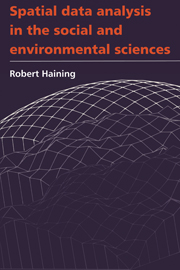Book contents
- Frontmatter
- Contents
- List of tables and displays
- Preface
- Acknowledgements
- PART A Introduction to issues in the analysis of spatially referenced data
- PART B Parametric models for spatial variation
- PART C Spatial data collection and preliminary analysis
- 5 Sampling spatial populations
- 6 Preliminary analysis of spatial data
- PART D Modelling spatial data
- Postscript
- Glossary
- References
- Index
6 - Preliminary analysis of spatial data
Published online by Cambridge University Press: 05 August 2012
- Frontmatter
- Contents
- List of tables and displays
- Preface
- Acknowledgements
- PART A Introduction to issues in the analysis of spatially referenced data
- PART B Parametric models for spatial variation
- PART C Spatial data collection and preliminary analysis
- 5 Sampling spatial populations
- 6 Preliminary analysis of spatial data
- PART D Modelling spatial data
- Postscript
- Glossary
- References
- Index
Summary
This chapter deals with preliminary forms of spatial data analysis, the purpose of which is to make an initial identification of data properties. The emphasis is on data description which should also be useful in developing hypotheses and shaping subsequent statistical analysis. The methods may also be useful for model assessment.
Section 6.1 describes methods for identifying distributional properties of observations. Such summaries may be of substantive interest but also help to indicate whether special data transformations will be required for subsequent statistical analysis. Ways of identifying trend and other forms of spatial arrangement or structure are also considered. This section draws on the methods of EDA (exploratory data analysis: Tukey, 1977; Hoaglin et al., 1983, 1985) adapted to the needs of spatial data analysis. We assume familiarity with standard methods of EDA and the interested reader should refer to these basic sources for more information. Wetherill et al. (1986; Chapter 2) provide a good introduction and many of the methods described below can be implemented using MINITAB. Section 6.2 overviews methods for testing for pattern in spatial data (spatial autocorrelation tests). This is an area already well covered in the literature and the section places these methods in context and discusses when different tests are appropriate. This part of the book draws on the work of Cliff and Ord (1981) and that of Hubert, Golledge and colleagues in the use of the generalised cross product statistic for spatial data analysis.
- Type
- Chapter
- Information
- Spatial Data Analysis in the Social and Environmental Sciences , pp. 197 - 246Publisher: Cambridge University PressPrint publication year: 1990
- 1
- Cited by

